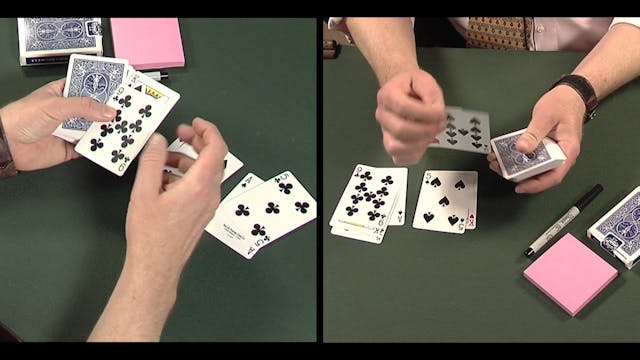The JM Rising Card
Bicycle Stripper Exclusive Learning Materials
•
4m 26s
WE ARE pleased to be able to offer through the courtesy of Jack McMillen, the inventor, a new method of working the rising card experiment that is certain to take its place among the thousand and one ways of working it already in existence. For impromptu work this has many distinctive features. Nothing is required save the cards, which may be borrowed. The card rises actually from the center of the pack, yet it is held squared up, neither thumb nor fingers being inserted in the pack to push the card up. And the principle employed to attain this effect is absolutely new. At the request of the performer anyone shuffles the pack and then deals off three cards. The magician picks up these three and requests a spectator to look at one of them. Nine times out of ten it will be the center card that is selected, but if not, the performer simply asks that a card be taken, and then has it replaced between the other two, so that it becomes the central one of the three. The three cards are laid momentarily face down on the table, while the pack is placed in the left hand, fingers on one side and thumb along the other. The top card of the three on the table is picked up and shoved into the center of the pack, but only half-way, being left projecting half its length from the end of the pack. The left thumb holds a break beneath it. The right hand takes up the next card from the table-the noted card-and shoves it half-way into the pack from the end, apparently directly below the card already pushed in. Actually the left thumb releases the card below the first of the three, so that there is a card between the two extending half-way from the pack. The last of three cards is picked up and pushed in below the others, but again the left thumb releases one of the cards of the pack so that the third card is inserted below. Thus we have the pack with three cards extending half their length from its end; unknown to the audience they are separated from each other by indifferent cards. The pack with the cards still projecting is turned over in the left hand so that the faces of the cards are to the audience. The pack is held with the first finger projecting out beyond the end, other fingers at one side and thumb at the other. The right hand is brought up so that it conceals the inner end of the pack. Now the left first finger pushed the three projecting cards into the pack, flush with the rest. This action causes the indifferent cards between the three to be pushed out the other end by friction. These two projecting cards are concealed by the right hand. Now the right hand held in such a manner that it keeps the projecting cards hidden, bevels the end of the pack spreading the cards downwards slightly at the end from back to front. The performer calls attention to what he is doing and explains that he is about to make the chosen card rise and is spreading the cards so that the spectators will be able to see that the card actually rises from the place where it was inserted. This feature does, incidentally, serve to make the feat more effective, but the real reason for spreading the cards downwards from the end is so that the face cards of the pack are brought down enough to conceal the projecting cards behind them when the right hand is taken away. The pack is held in the left hand with the fingers on one side and the thumb at the other, near the lower end, the cards being held upright. When working for just one or two spectators, there is no need to worry about angles. When working for more, the pack is held with the left side slightly towards the spectators. From this angle, the left fingers, holding the pack completely screen the cards projecting from the center, downwards, behind the front cards. The left little finger is placed under these two projecting cards and they are pushed up flush with the rest of the center cards. This causes the card between them, the selected card, to rise from the upper end of the pack. Due to the way the cards are spread it can be seen that the card is rising from the center of the pack. During the rising, the upper end of the pack is tipped slightly towards the spectators, to conceal the movement of the little finger. As soon as the projecting cards have been pushed up flush with the rest, the little finger resumes its place at the side of the pack as the performer offers it to the spectator that he himself remove his card from the position in which it has risen. All the cards are now in the position to which they were openly adjusted and examination of the chosen card, and the remainder of the pack as well will give no clue to the method employed.
Up Next in Bicycle Stripper Exclusive Learning Materials
-
Miraskill
I DON'T know where Mr. James got his title for this mystery, but any time anyone can produce such a problem I'll be the last to argue over what it is to be called. Certainly no concocted effect has in years been so original in effect upon the watchers. I have used the problem any number of times ...
-
Master Card Location
-
The Eclipse Vanish



